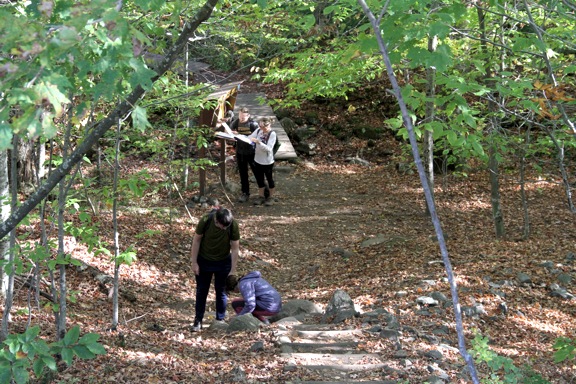No permits for High Peaks trails

Hikers sign in at the Cascade Mountain trailhead in September 2017. (News photo — Andy Flynn)
Let’s say the state of New York decides to institute a permit system for hikers and backcountry campers to gain access to the most popular trails in the High Peaks Wilderness Area, with the goal of protecting the resource — the woods, waters and wildlife. Yes, it would limit the number of people on the trails, but would all the current problems simply disappear?
No.
And that’s one reason we agree with state Department of Environmental Conservation Commissioner Basil Seggos when he says a user permit system should be the last resort. We’re simply not at the last-resort stage yet. How could we be? The state hasn’t put all its muscle into tackling the problem. And unless it does — with the same kind of zeal Gov. Andrew Cuomo has been fighting the coronavirus pandemic — things will only get worse for the Forest Preserve.
Let’s not limit access. Instead, let’s look at some of the biggest problems facing the High Peaks and see if we can get them under control before getting to a last-resort solution.
Education. There are a number of educational efforts underway in the High Peaks that are making a difference: frontcountry stewards, summit stewards, DEC-staffed backcountry information tables in Lake Placid, Keene and a Northway rest area in the town of North Hudson. The Adirondack Mountain Club, Adirondack Council, Protect the Adirondacks, DEC, Regional Office of Sustainable Tourism and other partners are teaching High Peaks hikers and campers Leave No Trace basics and diverting them away from the High Peaks. There’s more education today than there was a decade ago. But, as we’ve seen this summer with the increase in hiker traffic comes more pollution, improper human waste disposal, camping above 4,000 feet and illegal tree cutting. Much more education is needed — and will always be needed – even with a permit system.
Enforcement. The Adirondack Park needs more forest rangers. Period. The state has done a masterful job — spending millions of dollars –attracting visitors to the Adirondacks. Now it needs to step up — spending millions more — to educate the crowds and protect our more than 2.6 million acres of Forest Preserve. Getting more forest rangers in the woods — and not giving them meter-maid duties along state highways — will increase enforcement of the laws and help with education where it’s needed the most – on the trails. Increasing the number of assistant forest rangers could be a big part of the DEC’s on-the-ground education.
Parking. The state has limited parking along some of the busiest roadways that have access to the High Peaks Wilderness, particularly along state Route 73 in the towns of North Elba and Keene. Yet the state hasn’t adequately beefed up its state police or DEC patrols enough to properly enforce the law. The problem persists.
Just look at a video that was taken in the early afternoon of Friday, Sept. 4 along the Adirondack Loj Road and South Meadow Road. It was posted on Facebook this past weekend. We watched, and we counted about 300 cars parked along that section alone. The Adirondak Loj parking lot was full by the early morning hours, so that’s where the rest of the eager hikers found parking. Let’s fix this problem. The state should build more strategically placed parking areas such as here on the Adirondack Loj Road.
To its credit, the state has taken action to ease the parking and access situation for Cascade and Porter mountains. Once construction of the Mount Van Hoevenberg lodge is finished, that will be the new trailhead, adding mileage for hikers and ample parking for the crowds.
Hiker shuttle buses have proved successful for places such as The Garden trailhead in Keene and would be helpful for other popular trailheads. Let’s get more shuttles to where hikers want to go.
Trail maintenance. If the state is worried about the impact of traffic along the busiest trails in the High Peaks, perhaps a more robust trail maintenance program is in order.
With the ever-increasing popularity of outdoor recreation, the state Forest Preserve was in trouble before the coronavirus hit. Now it’s compounded with additional nature seekers escaping the cities and heading to our trailheads.
The DEC can only do so much with what it has. It needs more resources from Albany if we’re going to protect the Forest Preserve.
Drastic measures need to be taken … now, not later. Since its founding in 1892, the 6-million-acre Adirondack Park has been an ever-changing experiment — a balance between the environment and the economy. What we’re seeing now alarms us. The balance is shifting toward the economy, and the environment is suffering.



